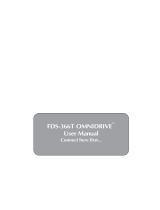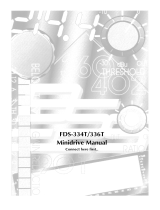
1. INTRODUCTION
First of all, we would like to thank you for and congratulate you on buying the Electro-Voice Digital Sound
System Processor Dx 38. To ensure an optimum in the performance of the appliance and to prevent any
damage resulting from erroneous or inadvertent handling or operation, please read this owner’s manual
carefully, before operating the Dx 38.
1.1 Dx 38 FEATURES
Providing 48-bit filter algorithms, 24-bit AD/DA conversion and a dynamic range of 115 dB, the Dx 38 sets
new standards for digital loudspeaker controllers and processors. The Dx 38 is an universal Digital Sound
System Processor that provides 2 inputs and 4 outputs; plus internal summing of the inputs 1 and 2. Via
matrix it is possible to assign the outputs to any input or to the sum of the inputs. It is further possible to
establish the following configurations: Stereo or Dual 2-Way systems, 3-Way + Direct and 4-Way systems,
each with Mono Sub-channel, but also full range systems.
High and low-pass filters are provided for the frequency crossover functions in all operation modes. The
selection includes Linkwitz-Riley, Butterworth and Bessel type filters with switchable slopes between 6,
12, 18 and 24 dB/oct. A huge number of additional filters offers extremely flexible correction of the
frequency response. Each input incorporates a 5-band equalizer, allowing to assign high and low-pass,
high and low-shelving or parametric peak-dip filters to its individual filter sections. Next to the frequency
crossover filters, four additional filters are employed in each output channel, which also can be set to work
as high or low-pass, high or low-shelving filters, parametric peak-dip filters, or all-pass filters. Additional
filtering is provided through 2. order high-passes for the realization of B-6 alignment, or special LPN-filters
(Low-Pass Notch filters) for correcting the frequency and phase responses of optimally vented woofer
cabinets. Each channel additionally provides a delay, a polarity switch, a programmable level control and
a digital compressor / limiter while the master delays are located in the input channels.
The user can choose between three operation modes: the “No Edit Mode” allows to simply select the
required combination of loudspeaker systems from the factory preset program list. Afterwards, the
appliance is optimally matched to the sound system and can be operated instantly. The “Standard Edit
Mode” also uses a pre-set basic program but with the exception that here, the user has access to the
selected amount of parameters. The “Full Edit Mode” on the other hand offers access to all parameters,
allowing to freely program and store basically any setting. A total number of 80 memory addresses - 50
preset and 30 freely assignable user-programs - are available.
Within the DX 38, AD/DA conversion is taken care of by linear 24-bit converters; where the AD-section
employs 128 times oversampling, gain-ranging Sigma-Delta converters. The DA-section offers 128 times
oversampling Sigma-Delta converters. The overall signal processing is performed by two 24-bit Motorola
signal processors.
Additional features are:
-FLASH memory for software and preset updates via serial interfaces
-PC-based operation and configuration software running under Windows ‘95 / Windows ‘98
-Standard MIDI-interface
-RS-232, RS-485 interfaces or switching contacts optionally available
-Back-lit graphic-display with 122 x 32 dots
-Inputs and outputs are electronically balanced, XLR-type connectors
-Input transformer-balancing is optionally available
-Input / Output level controls, Output-Mute switch, channel function indicators SUB, LO, MID, HI
-Input / Output meter instruments, compressor and clipping LEDs
Within this owner’s manual many of the Dx 38’s extensive features are explained in detail. Keep the
manual stored at a safe place to have it at hand for any further reference.
1.2 UNPACKING AND WARRANTY
Carefully open the packaging and take out the Dx 38. Remove the protective foil from the plexiglas of the
LC-display. Next to this owner’s manual, the appliance is shipped together with mains cord and warranty
card. Please make sure that the warranty card has been completed. Only with a fully completed warranty
certificate any possible warranty claims can be granted. The appliance comes with a 36 months warranty
which is valid starting with the original date of purchase; respectively when receiving the device from your
dealer. Please keep the warranty certificate, the original invoice and also the original packaging at a safe
place for any eventual shipping.
INTRODUCTION
1-4























